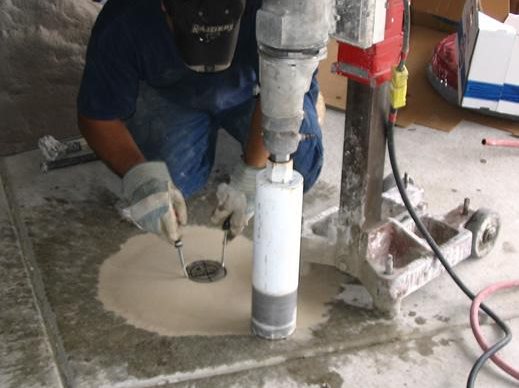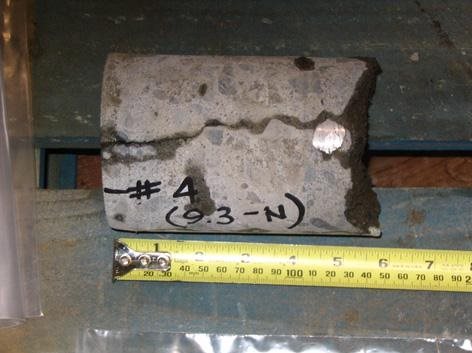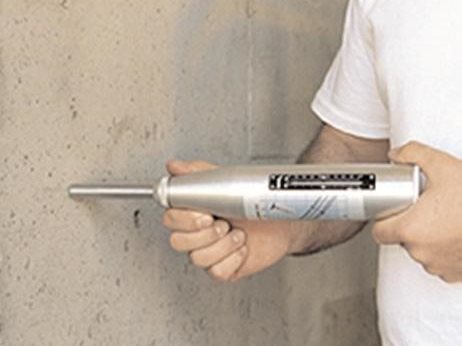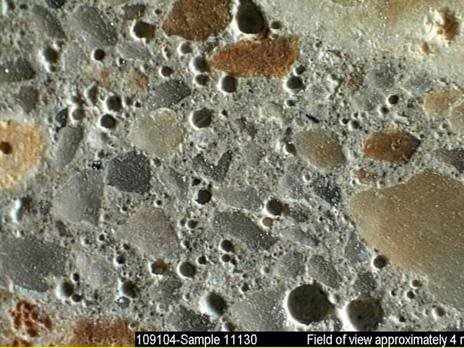Testing the Strength and Durability of Hardened Concrete
How to investigate problems with hardened concrete
Coring in progress. An R-meter was previously used to locate embedded reinforcing steel (shown marked in chalk). Core samples may be located to avoid or in some instances intercept steel.
A new concrete driveway you saw being placed a few months ago got your attention again as you drove by today. You see a meeting taking place on that driveway with what appears to be the homeowner, contractor and a couple of guys in suits with pads of paper taking notes. In the background, you notice a worker drilling into the driveway. Putting holes in a brand new driveway? What's going on?
The meeting you witnessed may be due to a homeowner who is dissatisfied with his final product. The source of dissatisfaction could be almost anything. Typical complaints include flaking or scaling of the surface, uncontrolled cracking, discoloration and popouts.
Projects of all sizes can encounter problems. Most are small enough that they can be quickly and economically resolved by contractors wanting to keep customers happy. However, some issues may require testing of the hardened concrete so you can identify the cause before conducting repairs. Otherwise, your repair efforts may not directly address the problem. There are several hardened concrete tests frequently used to examine concrete strength and durability. Be aware, however, that the costs of testing can be high and may even approach the cost of replacing the driveway. The costs for testing will vary across the country and with the quantity of samples examined.
Discuss the testing program with an experienced professional to set up a sampling/testing plan appropriate for the actual defect you might encounter. Here are the general steps involved in examining a defect and some common practices and tests typically used to search for the cause.
EXAMINING DEFECTS IN CONCRETE
Let's assume the driveway mentioned earlier has exhibited a durability problem, such as surface scaling. Here are a few preliminary steps to take in examining a concrete defect before actually testing the hardened concrete.
Take a condition survey.
Once all the project documents have been reviewed, the driveway slab should be visually surveyed and the conditions photographed to quantify the extent of the problem. The survey might include hammer tapping or chain dragging surfaces to detect unsound areas (ASTM D 4580, Standard Practice for Measuring Delaminations in Concrete Bridge Decks by Sounding). Plotting defects and other relevant characteristics such as cracks, popouts or scaling areas onto a sketch of the slab helps to assess the extent of defects and note patterns of interest.
Conduct sampling.
Concrete sampling is conducted so that material properties can be evaluated to establish the cause(s) of deterioration. Consult a technician, construction professional or engineer experienced in troubleshooting concrete problems when considering sample numbers and locations. It's frequently beneficial to obtain samples from so called "good" vs. "bad" spots to isolate the cause of some defects. Some guidance on sampling is provided in ASTM C 823, Examination and Sampling of Hardened Concrete. Although multiple tests can be conducted on a single core sample, limiting samples to one core is not recommended since a single sample may skew the results if the sample is nonrepresentative. If you can't find a local coring company or testing lab to cut core samples, go to the Concrete Sawing and Drilling Association website (www.csda.org) to locate a member near the project who can then provide you with an estimate to conduct the sample removal. CSDA members are located across the country and are well trained and equipped to handle a wide array of concrete cutting needs.
Choose a testing laboratory.
Concrete samples should be tested by a certified laboratory. Check with the laboratory on their experience dealing with the type of problem you are examining. Experience is a big plus, so you should select a particular testing lab based on experience and not just price alone.
DETERMINE THE COMPRESIVE STRENGTH OF HARDENED CONCRETE

Core diameters for compressive strength testing should be at least 3.7 inches in diameter. Preferred core length is two times the diameter. Core lengths less than 95% of a core diameter should not be tested for compressive strength.

Cores can be located to avoid rebar or intercept rebar location to gain insight on consolidation of concrete around steel and to confirm rebar size and position within the thickness of member.

The rebound hammer is essentially a surface-hardness tester used to provide a quick, simple means of checking concrete uniformity (ASTM C 805). It measures the rebound of a spring-loaded plunger after it has struck a smooth concrete surface. The rebound number gives an indication of concrete compressive strength and stiffness. (Photo courtesy of the Portland Cement Association)

The view a petrographer sees when microscopically examining the air-void system of concrete. The examination will provide total air content, air-void spacing, and specific surface of air voids in concrete. This information is compared to parameters known to be durable in freeze-thaw environments (ASTM C 457).
ASTM C 42, Obtaining and Testing Drilled Cores and Sawed Beams of Concrete.
This standard test method provides procedures for obtaining and testing specimens to determine compressive, splitting tensile, and flexural strength of in-place concrete. Common core diameters submitted for testing are 4 inches (actual diameter of 3.75 inches matching the inner diameter of a diamond-tipped core barrel). Core diameters should be a minimum of two times the maximum aggregate size. The preferred core diameter for a compressive strength specimen is three times the maximum aggregate size of the concrete (see section 7 of ASTM C 42). Length-to-diameter ratios are ideally 2:1, but this test method provides correction factors for ratios as low as 1:1. Note that for compressive strength to be considered structurally adequate, an average of 3 cores should be 85% of specified strength with no core falling below 75% of specified strength. Cores also allow a visible examination for general concrete characteristics, such as thickness of a slab if core is full depth, general degree of consolidation, aggregate distribution or signs of segregation.
ASTM C 805, Rebound Number of Hardened Concrete.
This is a frequently employed nondestructive test to assess concrete uniformity and estimate in-place compressive strength based on rebound numbers. Rebound numbers on tested concrete surfaces are correlated to compressive strength according to the vertical, horizontal or inclined direction of travel of the spring -loaded plunger. Calibration of rebound values with the actual project concrete test cylinders provides the most useful data. This test method is not intended as a basis for acceptance or rejection of concrete because of the inherent uncertainty in the estimated strength.
TESTING FOR CONCRETE DURABILITY
ASTM C 856, Petrographic Examination of Hardened Concrete.
This is probably one of the best examinations to consider since it provides information on the overall quality of a concrete. For example, it identifies the use of supplementary cementitious materials, such as fly ash or slag. Although not a mandatory parameter, many experienced petrographers can provide an estimate of the water-to-cement ratio of the concrete and estimate air content in the mix and relative distribution of air voids. Paste-aggregate bond, depth of carbonation, overall consolidation and many other concrete characteristics are also identified. Since the practice incorporates a microscopic examination of the concrete, it may identify concrete aspects not expected after the field observations of the problem and can redirect a test program to focus on a specific issue.
ASTM C 457, Air-Void Parameters in Hardened Concrete.
Issues of freeze-thaw durability are directly dependent on sufficient air content and a proper air-void system in the concrete. Recommended air content in concrete is correlated to the maximum aggregate size used in a mix. This test examines a cross-section of a concrete core, measuring air content and spacing factors of the microscopic air voids. In-place air-void characteristics are compared to established parameters known to provide durable concrete performance in a freeze-thaw environment. This is an important concrete characteristic to check, since having a sufficient amount of entrained air that is evenly distributed throughout the concrete plays a significant role in the durability of the material. ACI 318, "Building Code Requirements for Structural Concrete", Chapter 4 (available from the American Concrete Institute) provides recommended air contents based on the aggregate size used in a mix and the exposure class of the concrete.
ASTM C 174, Measuring Thickness of Concrete Elements Using Drilled Concrete Cores.
When slab thickness or member thickness is in question, measurement of core dimensions as described in this test method should be followed. When a test lab also has capabilities to conduct nondestructive testing, a good indication of slab thickness may also be determined with the use of ground penetrating radar (GPR).
ASTM C 1218, Water-Soluble Chloride Content in Concrete.
This test provides data concerning the water-soluble chloride content of concrete at the depth the concrete powder sample is taken. It is a frequently used test when premature freeze-thaw or corrosion problems are being examined. It may be useful to conduct tests near the concrete surface and toward mid-thickness of a slab. This helps indicate if chlorides were externally applied or originally added to the mix. ACI 318 provides chloride limits for new construction based on type of construction and test method selected to determine the percentage of chloride by mass of sample.
RELATED: Concrete Moisture Test




